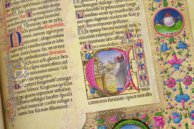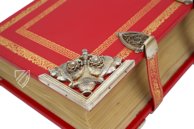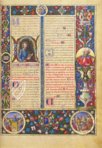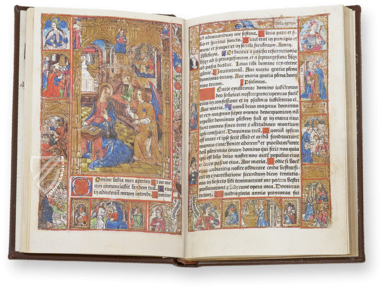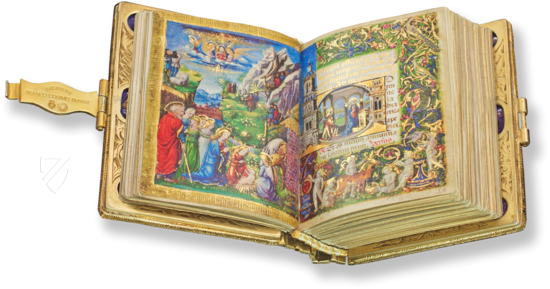Breviary of Ercole d'Este
(over 10,000€)
The so-called Breviary of Ercole d'Este is one of the highpoints of Ferrara's book illumination of the early Cinquecento. Created between 1502 and 1504, it is presented in an exuberant vestment of splendid book decoration: 56 smaller and larger miniatures, grandiose decorative frames and literally thousands of initials adorn the pages alongside the most delicate, elaborate ornamentation. Moreover, almost every one of the almost 1,000 pages is decorated with precious golden details. Ercole d'Este (1431–1505), Duke of Ferrara and great patron of the arts, had this splendour created by two gifted Renaissance book artists: Tommaso da Modena and Matteo da Milano, who had previously worked for the Medici, Orsini and several popes. Both are among the most important representatives of 16th century miniature painting. This makes the Breviary of Ercole d'Este a truly impressive testimony to the economic and cultural heyday of Ferrara under Ercole's rule!
Breviary of Ercole d'Este
The so-called Breviary of Ercole d'Este is one of the highpoints of Ferrara’s 16th century illumination. Originating from the year 1502 to 1504, it is presented in an exuberant vestment of fantastic illumination: small miniatures, grandiose decorative frames, and countless initials alongside embellishing, artful ornamentation. Matteo da Milano and Tommaso da Modena were the artists responsible for this splendor, significant representatives of the miniature painting of the time. The Breviary of Ercole d'Este is an impressive testimonial to the cultural heyday of Ferrara under his rule!
An Art-Oriented Duke
Ercole d’Este (1431–1505) was the Duke of Ferrara beginning in 1471. Under his direction, the Duchy of Ferrara developed into a commercial and cultural center in Italy. The most important artists were employed by Ercole. A particularly impressive testimonial of this great artistic age is the Duke’s personal prayer book, measuring 38 x 27 cm, it is unusually large and is representative of monumental manuscripts!
The Miniaturist of Popes and the Medici
The most important of Ferrara’s miniaturists were commissioned by the Duke: Matteo da Milano and Tommaso da Modena. Matteo da Milano (active 1492–1523) is considered to be the greatest miniaturist of his time and as such stood not only in the service of the Este in Ferrara, but also the Medici in Florence, and the Orsini in Rome, in addition to many other important patrons and even a few popes! Andrea della Vieze supported the work on the manuscript as a scribe. The late-Renaissance work of art was completed and presented to the Duke in 1504.
Impressive Paintings
The illumination of the breviary is composed of splendid frames, gorgeous calendars, and manifold miniatures – 45 full- and 11 half-page miniatures, as well was 40 smaller scenes – and an unbelievable 17,160 initials, 308 of which were gorgeously historiated. A precious gold background gleamed everywhere. The range of topics includes depictions of saints and biblical scenes. References to the patron and to Ferrara appear continuously, both in coats of arms and other heraldic symbols.
A Masterpiece of Ferrara’s Book Art
The manuscript is consistently distinguished by its stylistically and technically grandiose painting and is wonderfully supplemented by the beautiful Latin text. Arranged in two columns, it is characterized by the use of multicolored inks in black, red, and blue and the exquisite decoration of the fine ornamentation. Presented in this consummate splendor, the Breviary of Ercole d'Este is one of the highlights of the collection of the Biblioteca d’Este in Modena, which rests on the foundations of the famous library of the Dukes of Ferrara.
Codicology
- Alternative Titles
- Brevier des Ercole d'Este
Breviario di Ercole I D'Este
ms. Lat. 424
Breviarium secundum consuetudinem Romanae Curiae - Size / Format
- 986 pages / 38.0 × 27.0 cm
- Origin
- Italy
- Date
- 1502–1504
- Epochs
- Style
- Genre
- Language
- Script
- Gothic Textura
- Illustrations
- 45 full-page and 11 half-page miniatures, 40 smaller illuminations and 17,160 initials of which 308 are historiated
- Patron
- Ercole I d'Este, Duke of Ferrara (1431–1505)
- Artist / School
- Andrea della Vieze (scribe)
Matteo da Milano (illuminator)
Tommaso da Modena (illuminator)
Cesare and Andrea della Vieze (illuminators) - Previous Owners
- Alfonso I d' Este (1476–1534)
Josip Juraj Strossmayer, Bishop of Bosnia (1815–1905)
Zita of Bourbon–Parma, Empress of Austria (1892–1989)
Breviary of Ercole d'Este
March: Vintners Training Vines
During the month of Martius or March, miniatures for the labor of the month typically show farmers pruning, plowing, or otherwise preparing for spring planting. Since the manuscript originates from a wine growing region, this small medallion with a golden frame at the top left of the page shows vintners pruning vines and attaching them to a trellis. The hatless farmer in the purple tunic has holes in his white pants exposing his knees, which must be sore after so much bending and crouching.

Breviary of Ercole d'Este
King David
This spectacularly illuminated page is marked by bright primary colors that are enhanced by the black background and restrained use of shimmering gold leaf. In the primary scene, King David is shown composing his Psalms under a splendid Renaissance building as he looks up to God, who appears in the clouds above a detailed depiction of a gatehouse, which David enters on horseback.
Two more scenes from the life of King David are shown in medallions: on the bottom, a beardless young David is shown in the moment before he cuts off the head of Goliath, who is shown with blood streaming down his forehead from the stone that killed him; on the left, David presents Goliath’s severed head to King Saul, who names David as his successor.

#1 Breviario di Ercole I d'Este
Language: Italian
(over 10,000€)
- Treatises / Secular Books
- Apocalypses / Beatus
- Astronomy / Astrology
- Bestiaries
- Bibles / Gospels
- Chronicles / History / Law
- Geography / Maps
- Saints' Lives
- Islam / Oriental
- Judaism / Hebrew
- Single Leaf Collections
- Leonardo da Vinci
- Literature / Poetry
- Liturgical Manuscripts
- Medicine / Botany / Alchemy
- Music
- Mythology / Prophecies
- Psalters
- Other Religious Books
- Games / Hunting
- Private Devotion Books
- Other Genres
- Afghanistan
- Armenia
- Austria
- Belgium
- Belize
- Bosnia and Herzegovina
- China
- Colombia
- Costa Rica
- Croatia
- Cyprus
- Czech Republic
- Denmark
- Egypt
- El Salvador
- Ethiopia
- France
- Germany
- Greece
- Guatemala
- Honduras
- Hungary
- India
- Iran
- Iraq
- Israel
- Italy
- Japan
- Jordan
- Kazakhstan
- Kyrgyzstan
- Lebanon
- Liechtenstein
- Luxembourg
- Mexico
- Morocco
- Netherlands
- Palestine
- Panama
- Peru
- Poland
- Portugal
- Romania
- Russia
- Serbia
- Spain
- Sri Lanka
- Sweden
- Switzerland
- Syria
- Tajikistan
- Turkey
- Turkmenistan
- Ukraine
- United Kingdom
- United States
- Uzbekistan
- Vatican City
- A. Oosthoek, van Holkema & Warendorf
- Aboca Museum
- Ajuntament de Valencia
- Akademie Verlag
- Akademische Druck- u. Verlagsanstalt (ADEVA)
- Aldo Ausilio Editore - Bottega d’Erasmo
- Alecto Historical Editions
- Alkuin Verlag
- Almqvist & Wiksell
- Amilcare Pizzi
- Andreas & Andreas Verlagsbuchhandlung
- Archa 90
- Archiv Verlag
- Archivi Edizioni
- Arnold Verlag
- ARS
- Ars Magna
- ArtCodex
- AyN Ediciones
- Azimuth Editions
- Badenia Verlag
- Bärenreiter-Verlag
- Belser Verlag
- Belser Verlag / WK Wertkontor
- Benziger Verlag
- Bernardinum Wydawnictwo
- BiblioGemma
- Biblioteca Apostolica Vaticana (Vaticanstadt, Vaticanstadt)
- Bibliotheca Palatina Faksimile Verlag
- Bibliotheca Rara
- Boydell & Brewer
- Bramante Edizioni
- Bredius Genootschap
- Brepols Publishers
- British Library
- C. Weckesser
- Caixa Catalunya
- Canesi
- CAPSA, Ars Scriptoria
- Caratzas Brothers, Publishers
- Carus Verlag
- Casamassima Libri
- Centrum Cartographie Verlag GmbH
- Chavane Verlag
- Christian Brandstätter Verlag
- Circulo Cientifico
- Club Bibliófilo Versol
- Club du Livre
- CM Editores
- Collegium Graphicum
- Collezione Apocrifa Da Vinci
- Comissão Nacional para as Comemorações dos Descobrimentos Portugueses
- Coron Verlag
- Corvina
- CTHS
- D. S. Brewer
- Damon
- De Agostini/UTET
- De Nederlandsche Boekhandel
- De Schutter
- Deuschle & Stemmle
- Deutscher Verlag für Kunstwissenschaft
- DIAMM
- Droz
- E. Schreiber Graphische Kunstanstalten
- Ediciones Boreal
- Ediciones Grial
- Ediclube
- Edições Inapa
- Edilan
- Editalia
- Edition Deuschle
- Edition Georg Popp
- Edition Leipzig
- Edition Libri Illustri
- Editiones Reales Sitios S. L.
- Éditions de l'Oiseau Lyre
- Editions Medicina Rara
- Editorial Casariego
- Editorial Mintzoa
- Editrice Antenore
- Editrice Velar
- Edizioni Edison
- Egeria, S.L.
- Eikon Editores
- Electa
- Emery Walker Limited
- Enciclopèdia Catalana
- Eos-Verlag
- Ephesus Publishing
- Ernst Battenberg
- Eugrammia Press
- Extraordinary Editions
- Fackelverlag
- Facsimila Art & Edition
- Facsimile Editions Ltd.
- Facsimilia Art & Edition Ebert KG
- Faksimile Verlag
- Feuermann Verlag
- Folger Shakespeare Library
- Franco Cosimo Panini Editore
- Friedrich Wittig Verlag
- Fundación Hullera Vasco-Leonesa
- G. Braziller
- Gabriele Mazzotta Editore
- Gebr. Mann Verlag
- Gesellschaft für graphische Industrie
- Getty Research Institute
- Giovanni Domenico de Rossi
- Giunti Editore
- Graffiti
- Grafica European Center of Fine Arts
- Guido Pressler
- Guillermo Blazquez
- Gustav Kiepenheuer
- H. N. Abrams
- Harrassowitz
- Harvard University Press
- Helikon
- Hendrickson Publishers
- Henning Oppermann
- Herder Verlag
- Hes & De Graaf Publishers
- Hoepli
- Holbein-Verlag
- Houghton Library
- Hugo Schmidt Verlag
- Idion Verlag
- Il Bulino, edizioni d'arte
- ILte
- Imago
- Insel Verlag
- Insel-Verlag Anton Kippenberger
- Instituto de Estudios Altoaragoneses
- Instituto Nacional de Antropología e Historia
- Introligatornia Budnik Jerzy
- Istituto dell'Enciclopedia Italiana - Treccani
- Istituto Ellenico di Studi Bizantini e Postbizantini
- Istituto Geografico De Agostini
- Istituto Poligrafico e Zecca dello Stato
- Italarte Art Establishments
- Jan Thorbecke Verlag
- Johnson Reprint Corporation
- Josef Stocker
- Josef Stocker-Schmid
- Jugoslavija
- Karl W. Hiersemann
- Kasper Straube
- Kaydeda Ediciones
- Kindler Verlag / Coron Verlag
- Kodansha International Ltd.
- Konrad Kölbl Verlag
- Kurt Wolff Verlag
- La Liberia dello Stato
- La Linea Editrice
- La Meta Editore
- Lambert Schneider
- Landeskreditbank Baden-Württemberg
- Leo S. Olschki
- Les Incunables
- Liber Artis
- Library of Congress
- Libreria Musicale Italiana
- Lichtdruck
- Lito Immagine Editore
- Lumen Artis
- Lund Humphries
- M. Moleiro Editor
- Maison des Sciences de l'homme et de la société de Poitiers
- Manuscriptum
- Martinus Nijhoff
- Maruzen-Yushodo Co. Ltd.
- MASA
- Massada Publishers
- McGraw-Hill
- Metropolitan Museum of Art
- Militos
- Millennium Liber
- Müller & Schindler
- Nahar - Stavit
- Nahar and Steimatzky
- National Library of Wales
- Neri Pozza
- Nova Charta
- Oceanum Verlag
- Odeon
- Orbis Mediaevalis
- Orbis Pictus
- Österreichische Staatsdruckerei
- Oxford University Press
- Pageant Books
- Parzellers Buchverlag
- Patrimonio Ediciones
- Pattloch Verlag
- PIAF
- Pieper Verlag
- Plon-Nourrit et cie
- Poligrafiche Bolis
- Presses Universitaires de Strasbourg
- Prestel Verlag
- Princeton University Press
- Prisma Verlag
- Priuli & Verlucca, editori
- Pro Sport Verlag
- Propyläen Verlag
- Pytheas Books
- Quaternio Verlag Luzern
- Reales Sitios
- Recht-Verlag
- Reichert Verlag
- Reichsdruckerei
- Reprint Verlag
- Riehn & Reusch
- Roberto Vattori Editore
- Rosenkilde and Bagger
- Roxburghe Club
- Salerno Editrice
- Saltellus Press
- Sandoz
- Sarajevo Svjetlost
- Schöck ArtPrint Kft.
- Schulsinger Brothers
- Scolar Press
- Scrinium
- Scripta Maneant
- Scriptorium
- Shazar
- Siloé, arte y bibliofilia
- SISMEL - Edizioni del Galluzzo
- Sociedad Mexicana de Antropología
- Société des Bibliophiles & Iconophiles de Belgique
- Soncin Publishing
- Sorli Ediciones
- Stainer and Bell
- Studer
- Styria Verlag
- Sumptibus Pragopress
- Szegedi Tudomànyegyetem
- Taberna Libraria
- Tarshish Books
- Taschen
- Tempus Libri
- Testimonio Compañía Editorial
- Thames and Hudson
- The Clear Vue Publishing Partnership Limited
- The Facsimile Codex
- The Folio Society
- The Marquess of Normanby
- The Richard III and Yorkist History Trust
- Tip.Le.Co
- TouchArt
- TREC Publishing House
- TRI Publishing Co.
- Trident Editore
- Tuliba Collection
- Typis Regiae Officinae Polygraphicae
- Union Verlag Berlin
- Universidad de Granada
- University of California Press
- University of Chicago Press
- Urs Graf
- Vallecchi
- Van Wijnen
- VCH, Acta Humaniora
- VDI Verlag
- VEB Deutscher Verlag für Musik
- Verlag Anton Pustet / Andreas Verlag
- Verlag Bibliophile Drucke Josef Stocker
- Verlag der Münchner Drucke
- Verlag für Regionalgeschichte
- Verlag Styria
- Vicent Garcia Editores
- W. Turnowski Ltd.
- W. Turnowsky
- Waanders Printers
- Wiener Mechitharisten-Congregation (Wien, Österreich)
- Wissenschaftliche Buchgesellschaft
- Wissenschaftliche Verlagsgesellschaft
- Wydawnictwo Dolnoslaskie
- Xuntanza Editorial
- Zakład Narodowy
- Zollikofer AG






